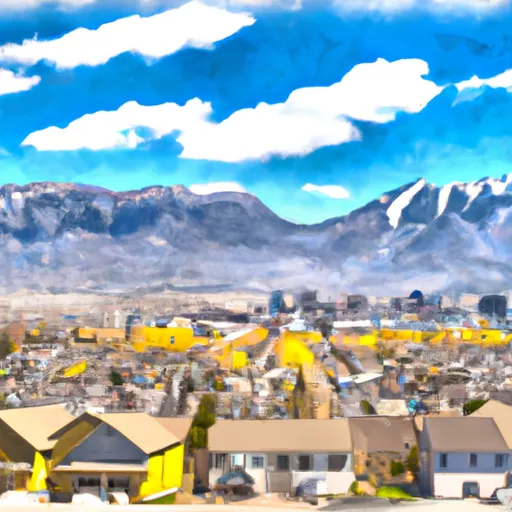-
 Snoflo Premium
Snoflo Premium
Get unlimited access to all our content
With no Ad interruptions! - Start Your Free Trial Login with existing account
Laketown
Eden Index
Climate
6.9
•
Recreation
2.8
•
Community
1.9
•
Safeguard
4.2/10

Laketown, Utah is a small town located in Rich County in northern Utah, near the shores of Bear Lake. It is known for its picturesque setting and offers a wide range of outdoor recreational opportunities.
The climate in Laketown is characterized by cold winters and mild summers. Winters bring heavy snowfalls, making it an ideal destination for winter sports enthusiasts. Summers are pleasant with warm temperatures, perfect for enjoying the lake and outdoor activities.
Situated near Bear Lake, Laketown benefits from the hydrology constituents of the lake. Bear Lake is a large freshwater lake renowned for its turquoise-blue waters, which occur due to the presence of calcium carbonate. The lake offers various water activities such as boating, fishing, swimming, and even scuba diving.
Additionally, Laketown is surrounded by beautiful mountains and forests, providing ample opportunities for hiking, camping, and wildlife viewing. The nearby national forest offers trails for ATV riding, horseback riding, and mountain biking.
In conclusion, Laketown, Utah, offers a picturesque setting with a unique climate, abundant water resources, and a wide range of outdoor recreation opportunities, making it an ideal destination for nature lovers and adventure seekers.
What is the Eden Index?
The Snoflo Eden Index serves as a comprehensive rating system for regions, evaluating their desirability through a holistic assessment of climate health, outdoor recreation opportunities, and natural disaster risk, acknowledging the profound impact of these factors on livability and well-being.
Climate Health Indicator (CHI): 6.9
Laketown receives approximately
343mm of rain per year,
with humidity levels near 65%
and air temperatures averaging around
6°C.
Laketown has a plant hardyness factor of
5, meaning
plants and agriculture in this region thrive during a short period during spring and early summer. Most
plants will die off during the colder winter months.
By considering the ideal temperature range, reliable water supplies, clean air, and stable seasonal rain or snowpacks, the Climate Health Indicator (CHI) underscores the significance of a healthy climate as the foundation for quality living.
A healthy climate is paramount for ensuring a high quality of life and livability in a region, fostering both physical well-being and environmental harmony. This can be characterized by ideal temperatures, reliable access to water supplies, clean air, and consistent seasonal rain or snowpacks.
Weather Forecast
Streamflow Conditions
Lower Bear
Area Rivers
Lower Bear
Snowpack Depths
Lower Bear
Reservoir Storage Capacity
Lower Bear
Groundwater Levels
Recreational Opportunity Index (ROI): 2.8
The Recreational Opportunity Index (ROI) recognizes the value of outdoor recreational options, such as parks, hiking trails, camping sites, and fishing spots, while acknowledging that climate plays a pivotal role in ensuring the comfort and consistency of these experiences.
Access to outdoor recreational opportunities, encompassing activities such as parks, hiking, camping, and fishing, is crucial for overall well-being, and the climate plays a pivotal role in enabling and enhancing these experiences, ensuring that individuals can engage in nature-based activities comfortably and consistently.
Camping Areas
| Campground | Campsites | Reservations | Toilets | Showers | Elevation |
|---|---|---|---|---|---|
| Montpelier Canyon | 13 | 6,241 ft | |||
| Bear Lake State Park | None | 5,949 ft |
Nearby Ski Areas
Catastrophe Safeguard Index (CSI):
The Catastrophe Safeguard Index (CSI) recognizes that natural disaster risk, encompassing floods, fires, hurricanes, and tornadoes, can drastically affect safety and the overall appeal of an area.
The level of natural disaster risk in a region significantly affects safety and the overall livability, with climate change amplifying these risks by potentially increasing the frequency and intensity of events like floods, fires, hurricanes, and tornadoes, thereby posing substantial challenges to community resilience and well-being.
Community Resilience Indicator (CRI): 1.9
The Community Resilience Indicator (CRI) recognizes that education, healthcare, and socioeconomics are crucial to the well-being of a region. The CRI acknowledges the profound impact of these elements on residents' overall quality of life. By evaluating educational resources, healthcare accessibility, and economic inclusivity, the index captures the essential aspects that contribute to a thriving community, fostering resident satisfaction, equity, and social cohesion.

